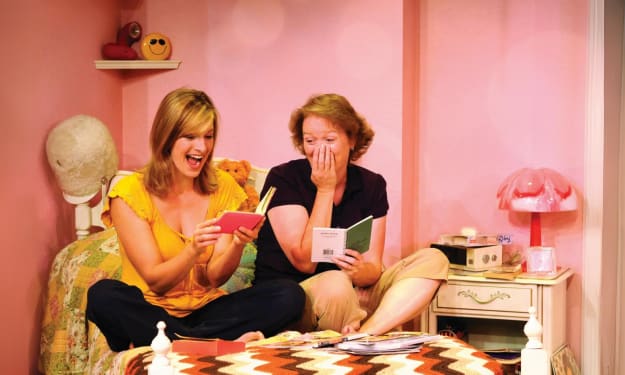Classic Movie Review 'Bonnie & Clyde'
A Classic Getting Another Look in the Podcast Era
Bonnie & Clyde, 1967, is a stunning movie of its moment. It’s chaotic and violent, a swirling cauldron of romanticized crime and Americana. The film is riddled with bullets and blood and guts and yet it’s not a horror movie. Bonnie & Clyde at once influenced the age of movies that came after it and doesn’t quite live up to the movement it presaged. For all of its reputation, Bonnie & Clyde is best remembered as the beginning of the American New Wave, the era of the superstar director and the end of the Hollywood Studio system.
Bonnie & Clyde stars Faye Dunaway as the ingenue Bonnie Parker and Warren Beatty as the handsome yet facile Clyde Barrow. While Bonnie appears to have brains and the ability to make a life if she wanted to, it’s not hard to see why she’s drawn to bad boy Clyde. Clyde is incredibly handsome and something of a blank slate. He has personality, he’s forceful, but not fully formed. He’s a fantasy that Bonnie can project upon.
The two meet as Clyde is perhaps trying to steal Bonnie’s mother’s car. She interrupts him, nude, standing in her bedroom window. She calls down for him to hold up and he waits for her and the two begin an odd tete a tete. Bonnie is walking to work at her job as a waitress but things take a tantalizing turn when she asks Clyde what he does for a living and he tells her he’s a bank robber. She’s hooked when he shows Bonnie his gun and she caresses the steel in an unseemly fashion.
That’s just the bait, however, the hook sinks in on Bonnie when she talks Clyde into proving he’s a real criminal. Clyde walks across the street and barely misses a beat as he robs a general store and the two of them flee the scene in a stolen car. If Bonnie has any qualms about being with a man who just robbed a store in her own hometown, she hides it pretty well. She clearly relishes the break from the monotony of small-town life in the dust bowl of Oklahoma in the 1930s.
That’s the setup, the rest of the movie is about building a legend, even if that legend is a tad bit full of holes. Bonnie and Clyde became legends for hot shotting through small towns in the southwest and knocking over banks but they weren’t criminal masterminds, they dumb kids playing at criminality because there isn’t anything better to do. Restlessness is the mark of this moment in time, the time of Bonnie & Clyde and it’s symbolic of the restlessness of the movie industry that the movie was upending when it was released and became a smash hit in 1967.
The style of Bonnie & Clyde is greatly influenced by the French New Wave which was just about to crest and crash in Europe and was now arriving in America as something shiny and new. This is a director-driven era where style was as important as story and Bonnie & Clyde was a film with style to spare. The costumes, the cars, the perfect period setting, are as important as anything to do with plot or story in Bonnie & Clyde.
The story is treated as rather mundane, a group of overgrown children on a violent joyride, robbing and killing to keep from having to grow up, get jobs and assimilate into sensible society. The standout element is director Arthur Penn’s offhand, observant style that places a high importance on the look of a scene and less of an interest in the content of a scene. That’s not to say the story or the content is subpar, but the style is the standout, the look and feel of a scene, is where Arthur Penn’s interest lies.
He can get away with that because his stars are Warren Beatty and Faye Dunaway, a pair of actors at the height of their glamour. Getting them in the same frame might be enough to burn a hole in the screen. Putting them in fabulous period outfits with tommy guns and classic cars, and allowing them to be impossibly beautiful is as much part of the genius of Bonnie & Clyde as anything to do with this iconic story.
The other aspect of Bonnie & Clyde is the commentary on media and society. Bonnie and Clyde were among the first celebrities of the media age, even as they were criminals. Newspapers followed their every move and, stealing a line from a famed western, they printed the legend. Bonnie and Clyde likely didn’t rob a third of the banks they were credited with, newspapers pinned things on the so-called Barrow gang because Bonnie and Clyde’s legend sold newspapers.
The media critique isn’t a takedown of media culture but a damning demonstration of some terrible journalism for sure. Some have also talked about the way the police are depicted in the movie as symbolic of police brutality at the time. There is something to be said about the horrifically unsafe and extreme lengths law enforcement went to capture Bonnie & Clyde but Arthur Penn has dismissed the notion of whether he intended the film to be a satiric look at either the media or the police.
Bonnie & Clyde is, in many ways, its own kind of legend. The film is quite good, an influence on everything from The Godfather movies to Texas Chainsaw Massacre, in the offhand, observant way that Penn films crime. There is no glorifying going on, it’s about the presentation of crime. The actions of these characters, no matter how immoral, or monstrous, are inescapable in the confines of the movie theater and we are forced to confront death and crime up close and personal.
That was a very different approach from that of the studio era where criminals always got caught by heroic police officers who were never anything less than heroic. Violence in the studio era was always punished by the swift hand of justice but not in hales of bullets the audience could see. If being caught meant death it was swift in the fashion of how it was filmed, bodies weren’t lingered over and the manner of death was most often bloodless, even if was a bullet.
Bonnie and Clyde are certainly met with the swift hand of justice but Arthur Penn’s innovation was to make us watch it. You may want to see the murderous duo captured but do you have the stomach for how they were captured? That’s the confrontation, the taunt of that remarkable ending to Bonnie & Clyde. There may be a classic sort of puritanism to the criminals getting caught but Arthur Penn was among the first filmmakers who forced us to confront the brutality.
It’s very much the idea of seeing how the sausage is made. We want to see the killers brought to justice but do you have the stomach to watch it happen? Are the police in Bonnie & Clyde heroes? Would heroes really need to shoot a man and a woman so many times that their bodies couldn’t be embalmed? The embalming fluid kept finding bullet holes. Penn makes you watch and then the movie is over and you don’t have a moment to breathe. The lights come up and you’re headed out of the theater with that last bloody, violent image following you home.
If you’re interested in more on Bonnie & Clyde, the movie was recently featured on the podcast Unspooled with actor-comedian Paul Scheer and film critic Amy Nicholson in a terrifically entertaining episode. The film was also recently the classic on my own podcast, Everyone’s a Critic with co-hosts Bob Zerull and Josh Adams. That episode is available at I Hate Critics.
About the Creator
Sean Patrick
Hello, my name is Sean Patrick He/Him, and I am a film critic and podcast host for the I Hate Critics Movie Review Podcast I am a voting member of the Critics Choice Association, the group behind the annual Critics Choice Awards.






Comments
There are no comments for this story
Be the first to respond and start the conversation.